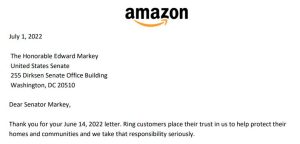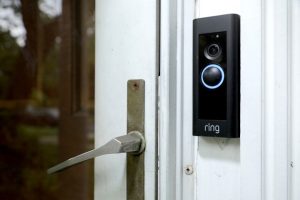Cops on your Front Porch
By Irene Shaffer | October 24, 2022
Some technology companies, including Amazon and Google, will share footage from smart doorbells with law enforcement without a warrant and without consent of the owner.

In case of emergency
In a letter to Senator Edward Markey earlier this year, Amazon confirmed that it has provided Ring doorbell footage to law enforcement on several occasions without consent from the owner of the doorbell and without a warrant. Amazon claims that such disclosures are made only when there is “a good-faith determination that there was an imminent danger of death or serious physical injury to a person requiring disclosure of information without delay” (Amazon, 2022). However, this admission from Amazon created a whirlwind of news stories about the perceived invasion of privacy. Although this emergency usage of footage was in accordance with the privacy policy of the Ring device, it clearly violated users’ reasonable expectation of privacy for a device that they install at their home.
In this article, we explore two questions. First, should it ever be justifiable to share footage from a private recording device without consent and without a warrant? Second, what should a privacy-conscious user look for in the terms of service of a smart doorbell device?
Should video ever be shared without consent?
Amazon claims that it only shares videos in this way in the case of emergencies; however, there is no legal requirement for a company to disclose user data in the absence of a warrant or other court document requiring that the data be provided to law enforcement. In fact, several manufacturers of smart doorbells, including Arlo, Wyze, and Anker, have all confirmed that they will not share data without either consent or a warrant, even in the case of emergency (Crist, 2022). However, Google has the same policy as Amazon, although Google claims to have not yet shared any video footage in such an emergency situation (Crist, 2022).
Ideally, a company’s stance on this issue should be front and center in the privacy policy for the device so that no user is caught by surprise when their data is shared with law enforcement. Although Ring’s privacy policy does a good job of fulfilling the recommendations of the California Online Privacy Protect Act (CalOPPA) document, including “use plain, straightforward language” and “avoid technical legal jargon”, Ring’s published policy for sharing video with law enforcement is somewhat contradictory (California Department of Justice, 2014). In the first section, it states:
Ring does not disclose user information in response to government demands (i.e., legally valid and binding requests for information from law enforcement agencies such as search warrants, subpoenas and court orders) unless we’re required to comply and it is properly served on us.
However, in a later section titled “Other Information”, the emergency policy is specified:
Ring reserves the right to respond immediately to urgent law enforcement requests for information in cases involving imminent danger of death or serious physical injury to any person.
On the surface, this seems to contradict the first statement and may confuse users who do not read all the way to the bottom of the policy.
What should privacy-conscious consumers look for?
For users who are truly privacy conscious, the best solution is a closed-circuit camera which does not upload to the cloud. However, this is much less convenient than an internet connected device. To ensure privacy while also benefitting from the convenience of the cloud, the ideal solution is an end-to-end encrypted service which allows only the owner of the doorbell to decrypt and view recordings. In this way, the service provider is unable to access the video, even in the case of an emergency or court ordered request from law enforcement. End-to-end encryption is available from many major smart doorbell providers, including Ring, which has been rolling out this feature to its devices over the past year (Ring, 2022). Although Ring provides many warnings about features which will be lost due to encryption, a user who wants control over their data should gladly accept this tradeoff.
References
Amazon. (2022, July 1). Amazon Response to Senator Markey. Retrieved from United States Senator for Massachusetts Ed Markey: https://www.markey.senate.gov/imo/media/doc/amazon_response_to_senator_markey-july_13_2022.pdf
California Department of Justice. (2014). Making Your Privacy Practices Public.
Crist, R. (2022, July 26). Ring, Google and the Police: What to Know About Emergency Requests for Video Footage. Retrieved from CNET: https://www.cnet.com/home/security/ring-google-and-the-police-what-to-know-about-emergency-requests-for-video-footage/
Ring. (2022). Ring Law Enforcement Guideliens. Retrieved from Ring: https://support.ring.com/hc/en-us/articles/360001318523-Ring-Law-Enforcement-Guidelines
Ring. (2022). Understanding Video End-to-End Encryption (E2EE). Retrieved from Ring: https://support.ring.com/hc/en-us/articles/360054941511-Understanding-Video-End-to-End-Encryption-E2EE-
Senator Markey’s Probe into Amazon Ring Reveals New Privacy Problems. (2022, July 13). Retrieved from United States Senator for Massachusetts Ed Markey: https://www.markey.senate.gov/news/press-releases/senator-markeys-probe-into-amazon-ring-reveals-new-privacy-problems

